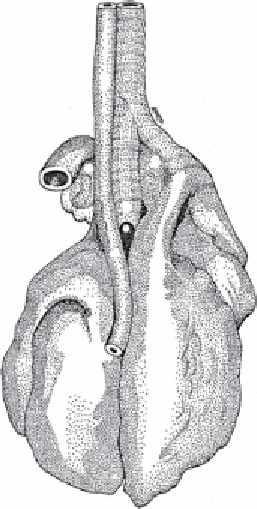Agriculture Reference
In-Depth Information
follows: cattle, 226-340 g; horse, 340 g; sheep, 85-142 g;
and pig, 28-56 g.
Respiratory system
f
d
The much smaller thoracic cavity (containing the lungs,
heart and associated large vessels) is separated from the
abdominal cavity (in which all the other body organs are
situated) by the strong musculomembranous
diaphragm
(convex in front and concave posteriorly).
The respiratory system comprises the nose, nasal cav-
ity, part of the pharynx, larynx, trachea and lungs.
Respiration allows an adequate intake of oxygen and the
removal of carbon dioxide by bringing blood in the lungs
into close proximity with the alveolar air.
The pleura lines the chest cavity and in the healthy
animal is a smooth, glistening membrane divided into
a right and left sac. Each sac covers the chest wall
(the parietal pleura) and the lung (the visceral pleura).
The two sacs (pleurae) join in the central mediastinal
space in which are situated the mediastinal lymph nodes
and which is traversed by the aorta, oesophagus and
trachea.
b
a
c
e
Figure 2.10
Lymph nodes of the bovine lungs. a, left bronchial
partly covered by the aorta; b, right bronchial; c, middle bronchial;
d, apical; e, posterior mediastinal; f, anterior mediastinal, related
inferiorly to the oesophagus and trachea.
Lungs
Ox (Fig. 2.10)
The cartilaginous rings of the ox trachea meet at an angle
and form a distinct ridge along the dorsal aspect. The
left
lung
has three lobes named, from before backwards, the
apical, cardiac and diaphragmatic. The
right lung
has
four or five lobes, its apical lobe receiving an accessory
bronchus from the trachea. The lung lobulation is well
marked by the large amount of interlobular tissue and is
particularly evident in old cows. The pair of ox lungs
weighs 2.2-3.0 kg.
Horse
The lobar divisions are very indistinct in the horse;
only two left lobes and three right lobes can be clearly
distinguished. The horse lungs are long and may be
further differentiated from those of the ox by the
absence of surface lobulation and the absence of an
accessory bronchus, while the ends of the cartilaginous
rings of the trachea overlap like a piston ring. The horse
lungs weigh 2.2-3.0 kg.
Sheep
Sheep lungs resemble those of the ox in the division of
the lobes, but their consistency is more dense and leath-
ery, they are duller in colour, and the lobulation is less
distinct. They weigh 340-907 g.
Pluck
In the pig, sheep and calf, the internal organs compris-
ing the larynx, trachea, lungs, heart and liver constitute
the
pluck
. In the pig pluck, the oesophagus remains
attached and is related to the trachea, which is short and
consists of 32 cartilaginous rings. In the sheep, the
oesophagus is removed with the stomachs in the dress-
ing of the carcase. The trachea is long and composed of
about 50 rings.
Pig
The number of lobes varies, with two to three on the left
and three to four on the right, because the apical and car-
diac lobes can be subdivided. The tissue is very spongy
and compressible, and the surface lobulation is particu-
larly well marked. Of all the food animals, the pig lungs
show the greatest variations in colour, varying from red
to light pink, but these variations are due to slight varia-
tions in the amount of blood left in the lungs after bleed-
ing and are of no pathological significance. The pig lungs
weigh 340-453 g.
Circulatory system (heart, arteries,
capillaries and veins)
Heart
The heart, a hollow muscular organ acting as a pump,
lies in the pericardial sac in the mid-mediastinal region
of the thorax between the lungs. Its muscular portion,

